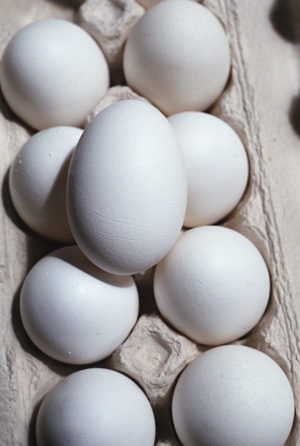According to a recent USDA study of organic versus factory eggs, you are wasting your money purchasing anything other than conventional grocery store eggs since there is no difference in terms of their fat and protein content. However, the USDA study was flawed.
The study, “Physical Quality and Composition of Retail Shell Eggs,” published in the March 2010 issue of the journal Poultry Science and written up in Time magazine, used different kinds of eggs from Georgia grocery stores — cage-free, free-roaming, pasteurized, omega-3 enhanced, fertile, organic and conventional. The USDA team of food technologists used a Haugh unit — an egg-quality metric developed in 1937. According to the researchers, the white of an egg is where all the protein is found; it is made of both thin albumen, the watery fluid that runs furthest from the yolk when the egg is cracked into a cold pan, and thick albumen, the more viscous fluid that stays closer to the middle. The greater the amount of thick albumen, the more nutritious the egg, according to the testers.
“The Haugh unit factors together the weight of the egg and the thickness of the albumen layer at the center,” said team leader Deana Jones. And that number, she found in her study, is not affected by how a hen is raised. “We found no meaningful differences at all,” she said. “We sampled eggs from a number of stores and kept getting the same results over and over. For shoppers, the decision comes down to your ethical and moral choices.”
The group “Beyond Pesticides” says the study missed all the important points. It failed to examine nutritional factors that farmers using organic methods often claim to be higher in organic eggs, such as vitamins A and E, beta carotene, folate and omega-3 fatty acids. Nor did it measure pesticide content or consider that organic poultry and egg production also prohibits the prophylactic use of antibiotics and arsenic in chicken feed. Nor did it consider the environmental and health impacts of conventional, chemical-based production systems on workers and nearby farms.
Still others wondered what book the USDA has been reading; most of an egg’s nutrition is in the yolk, not the white. It is the egg yolk that contains fat, plus most of the vitamins and minerals of the egg. An egg yolk contains approximately 2.7 grams of protein, an egg white about 3.6 grams. Many people were puzzled that the test was done with the Haugh unit. In 1937, when the Haugh unit was devised, we did not know much about vitamins. Today, a Haugh unit is used to determine if an egg is stale.
Time magazine ran with the USDA press release, but did not bother to contact an organic group to get their side of the story. Judging by many of the comments people posted to the Time story, readers were not buying the validity of this study either. “To compare the nutritious value of one egg to another by weighing it is like measuring the intelligence of someone by weighing their brain.” And this comment to the Beyond Pesticides article: “Trusting the USDA — which has long carried water for industrial agriculture interests … is only marginally saner than trusting the American Petroleum Industry to conduct a study of oil-drilling safety in the Gulf of Mexico.”
Sources: Time Magazine, July 8, 2010, www.time.com/time/ health/article/0,8599,2002334,00.html, USDA Research Project: Egg Processing Safety, Quality and Security. Published March 1, 2010., Beyond Pesticides: USDA Study Compares Organic and Conventional Eggs, but Misses Big Picture. July 12, 2010.
Reprinted from AzNetNews, Volume 30, Number 5, October/November 2011.






August 16, 2012
Food, Food, Nutrition and Diet, Nutrition, Organic